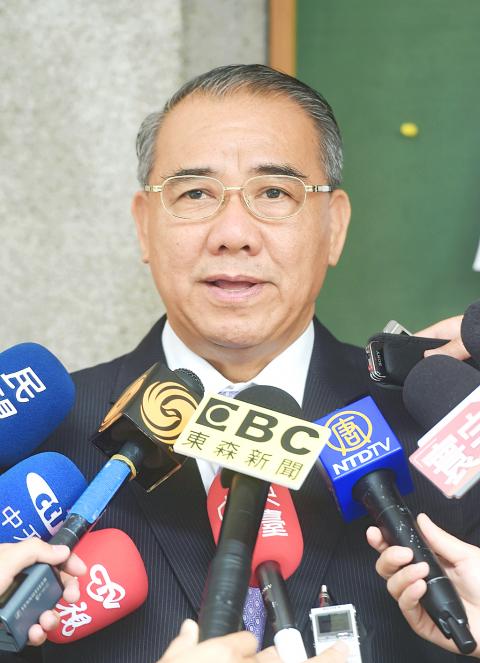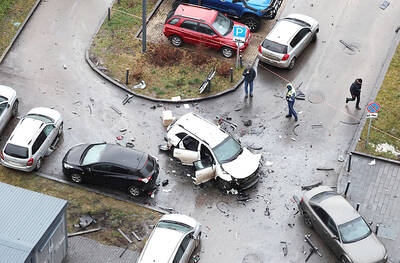Members of the Chinese Nationalist Party (KMT) caucus have been calling for a party-wide consensus on “one China, different interpretations,” as preparations are under way for a meeting between the KMT chairwoman and Chinese authorities in Beijing next month to discuss cross-strait ties.
In a bid to prevent a repeat of recent conflict over the matter, the caucus yesterday again said that KMT Chairwoman Hung Hsiu-chu (洪秀柱) must adhere to the so-called “1992 consensus” of “one China, different interpretations.”
Conflicts within the party emerged when Hung pushed for “one China, same interpretation” to be adopted.

Photo: Fang Pin-chao, Taipei Times
The “1992 consensus” is a term former KMT lawmaker Su Chi (蘇起) admitted making up in 2000 when he was head of the Mainland Affairs Council. It refers to a tacit understanding between the KMT and the Chinese government that both sides of the Taiwan Strait acknowledge that there is “one China,” with each side having its own interpretation of what “China” means.
Hung is to meet Chinese President Xi Jinping (習近平) next month at a forum on “peaceful cross-strait development.”
The KMT says “one China, different interpretations” gives Taiwan an advantage in cross-strait relations.
A statement issued by the KMT caucus yesterday said that Taiwan and China have entered a period of “cold peace,” which it said must be overcome through normal communications.
The KMT hopes for more opportunities to engage with China and has suggested an exchange of ideas on peaceful development, the statement said.
The statement said that prior to exchanges or implementation of important cross-strait policies, the party headquarters should comprehensively brief the caucus, adding that it would get input from the public to “signify the importance placed on public opinion within the party’s central leadership and improve the effectiveness of promoting exchange activities.”
KMT caucus convener Sufin Siluko (廖國棟) said cross-strait peace is a huge topic, adding that he supports Hung’s attendance at the Beijing forum.
He said the forum would allow “Taiwan’s voice to be heard in Beijing,” adding that he hopes Hung can express the caucus’ stance on the “1992 consensus” at an opportune time.
He said that five legislators are to attend the forum and that the caucus would not stand in the way of anyone who sought to attend, adding that it would be best if all 35 KMT lawmakers were in their legislative seats next month with the next session expected be a tug-of-war.
KMT Legislator Lin Te-fu (林德福) said that while legislators are talking about whether to attend the forum in Beijing, there is still no consensus within the party itself.
He said that the caucus and the party’s central leadership must work together to ensure good communication.
Lin said that Hung should look at what was said at past meetings between KMT heads and Xi, adding that he believes Hung should “be smart enough to say one China, different interpretations, just as former president Ma Ying-jeou (馬英九) did.”
“I am sure the Chinese authorities will understand our position. The ideas brought up by the caucus should be valued by them,” Lin said.
KMT Culture and Communications Committee director Chow Chi-wai (周志偉) said that the caucus’ position on cross-strait interaction is in agreement with the party’s central leadership.
He said that the KMT would continue building on the established foundation of promoting cross-strait interaction, peaceful policies and economic development.
Chow said the caucus is the division of the party most capable of participating in and supervising the central government, adding that he hopes the party would work in unity to put the KMT back in power.

TRAGEDY STRIKES TAIPEI: The suspect died after falling off a building after he threw smoke grenades into Taipei Main Station and went on a killing spree in Zhongshan A 27-year-old suspect allegedly threw smoke grenades in Taipei Main Station and then proceeded to Zhongshan MRT Station in a random killing spree that resulted in the death of the suspect and two other civilians, and seven injured, including one in critical condition, as of press time last night. The suspect, identified as a man surnamed Chang Wen (張文), allegedly began the attack at Taipei Main Station, the Taipei Fire Department said, adding that it received a report at 5:24pm that smoke grenades had been thrown in the station. One man in his 50s was rushed to hospital after a cardiac arrest

SAFETY FIRST: Double the number of police were deployed at the Taipei Marathon, while other cities released plans to bolster public event safety Authorities across Taiwan have stepped up security measures ahead of Christmas and New Year events, following a knife and smoke bomb attack in Taipei on Friday that left four people dead and 11 injured. In a bid to prevent potential copycat incidents, police deployments have been expanded for large gatherings, transport hubs, and other crowded public spaces, according to official statements from police and city authorities. Taipei Mayor Chiang Wan-an (蔣萬安) said the city has “comprehensively raised security readiness” in crowded areas, increased police deployments with armed officers, and intensified patrols during weekends and nighttime hours. For large-scale events, security checkpoints and explosives

PUBLIC SAFETY: The premier said that security would be tightened in transport hubs, while President Lai commended the public for their bravery The government is to deploy more police, including rapid response units, in crowded public areas to ensure a swift response to any threats, President William Lai (賴清德) said yesterday after a knife attack killed three people and injured 11 in Taipei the previous day. Lai made the remarks following a briefing by the National Police Agency on the progress of the investigation, saying that the attack underscored the importance of cooperation in public security between the central and local governments. The attack unfolded in the early evening on Friday around Taipei Main Station’s M7 exit and later near the Taipei MRT’s Zhongshan

A car bomb killed a senior Russian general in southern Moscow yesterday morning, the latest high-profile army figure to be blown up in a blast that came just hours after Russian and Ukrainian delegates held separate talks in Miami on a plan to end the war. Kyiv has not commented on the incident, but Russian investigators said they were probing whether the blast was “linked” to “Ukrainian special forces.” The attack was similar to other assassinations of generals and pro-war figures that have either been claimed, or are widely believed to have been orchestrated, by Ukraine. Russian Lieutenant General Fanil Sarvarov, 56, head